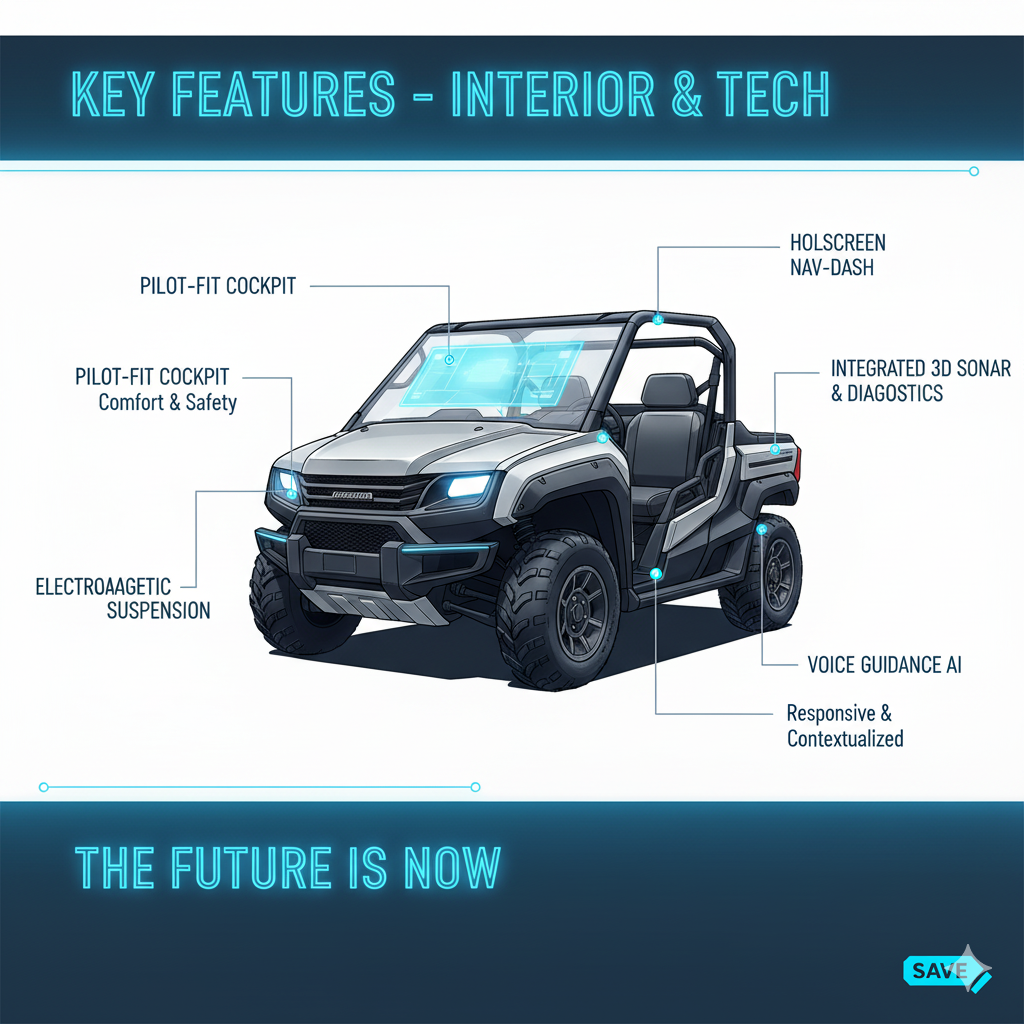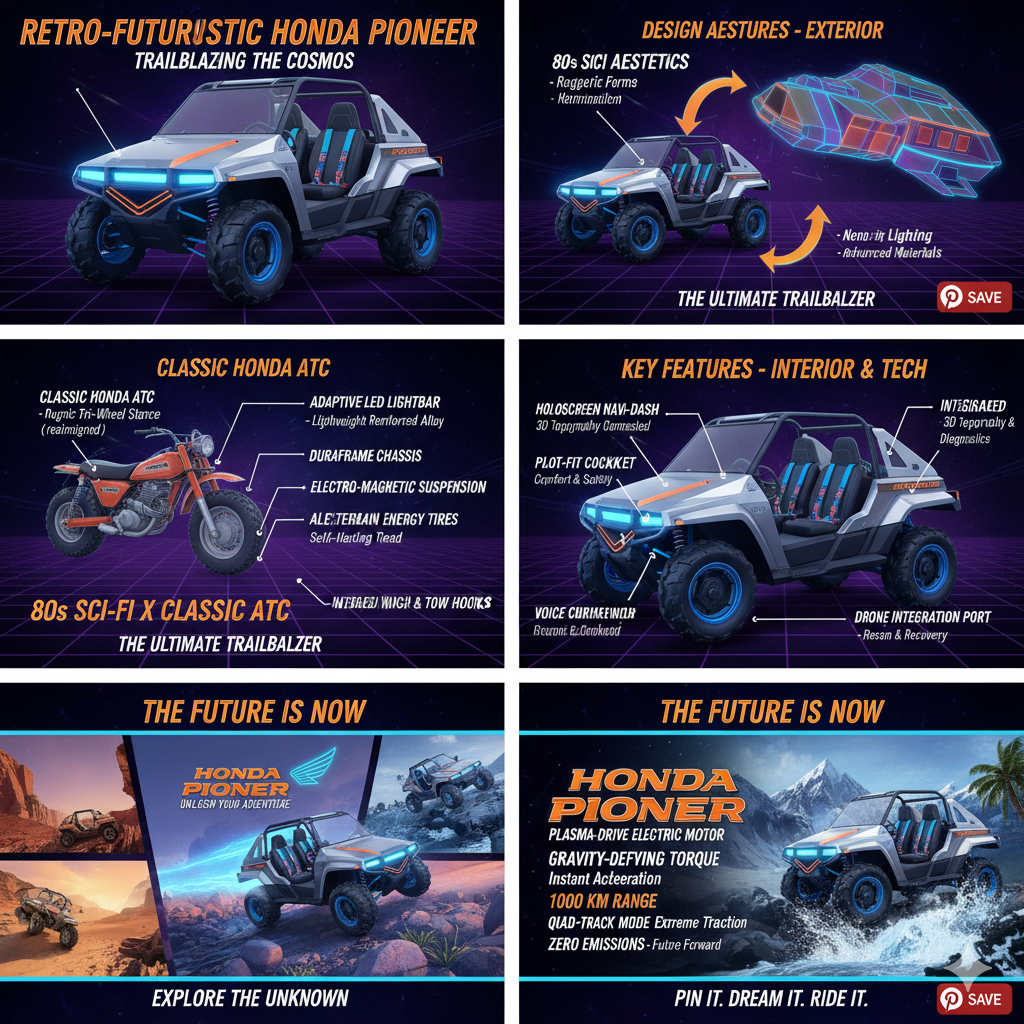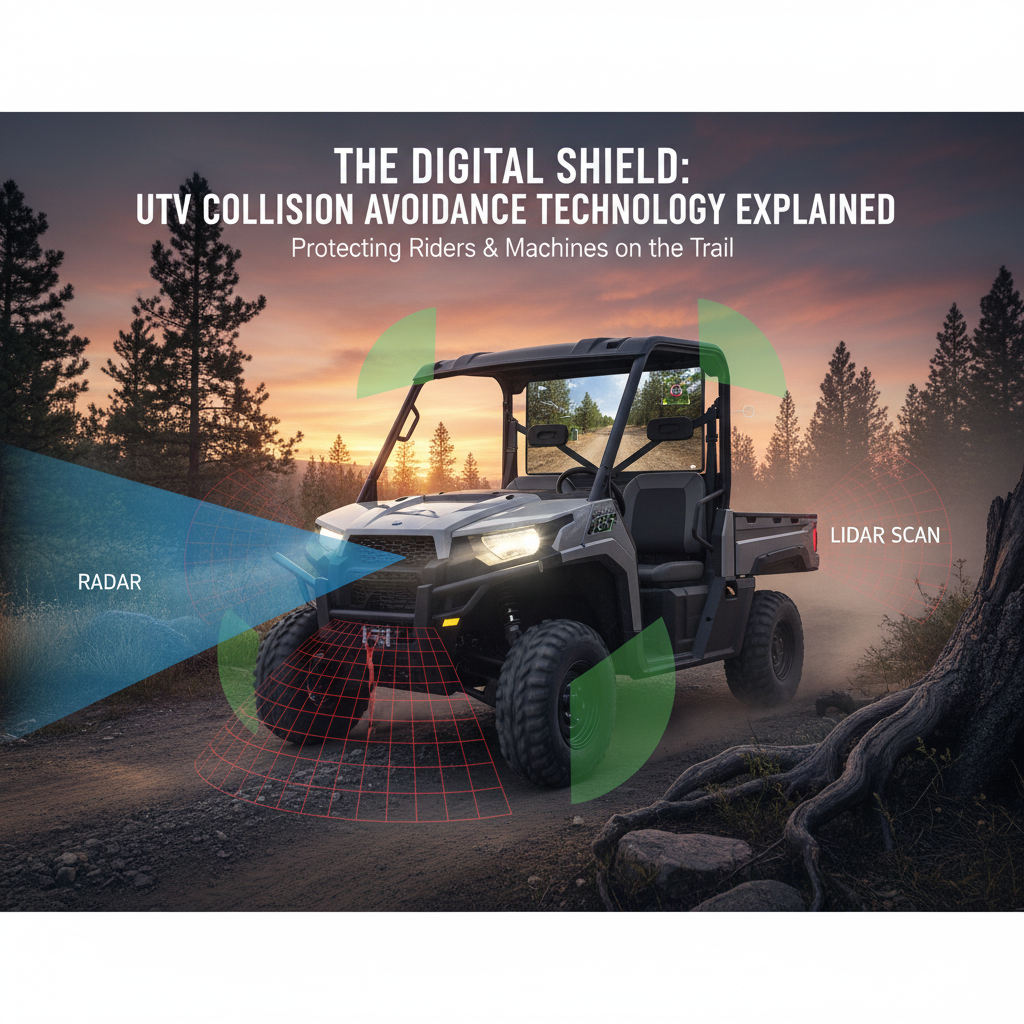Hey everyone, welcome back!
If you’re anything like me, you don’t just love the now of off-roading; you love the what if.
We’ve all seen the sleek, aggressive lines of modern UTVs, but lately, I’ve been obsessed with a different vision: Retro-Futurism.
What if the designers at Honda looked back at the chunky, utilitarian beauty of the Big Red ATC or the sharp, angular lines of the first-generation FourTrax and used that as a launchpad for the next-generation Pioneer?
This isn’t about simply slapping a new coat of paint on an old machine.
Retro-futurism is a design philosophy that imagines the future as seen through the eyes of the past.
It’s about merging the optimistic, often blocky and functional aesthetic of the 1970s and 80s with the hyper-advanced technology of the 2030s.
And frankly, the Honda Pioneer platform is the perfect canvas for this kind of creative madness.

The Aesthetic Blueprint: Honda’s Golden Age
To design a truly retro-futuristic Pioneer, we need to identify the key design elements from Honda’s past that scream “future, but from 1985.”
| Vintage Honda Element | Retro-Futuristic Adaptation | Pioneer Application |
|---|---|---|
| Boxy, Functional Body Panels | Sharp, geometric forms with exposed fasteners and minimal curves. | A Pioneer body kit made of modular, easily replaceable, high-density polymer panels. Think Cyberpunk meets Big Red. |
| Exposed Tubular Frame | A visible, color-coded roll cage and chassis components, emphasizing structural integrity. | A redesigned Pioneer roll cage with integrated LED light bars that look like they belong on a space rover. |
| Analog-Style Gauges | Digital displays with graphics that mimic vintage analog dials, complete with faux needles and segmented LCD fonts. | A Pioneer dash with a customizable screen that can switch to a “Classic ATC” mode. |
| Massive, Low-Pressure Tires | Modern, high-performance radial tires with an exaggerated, chunky tread pattern and bright, color-matched wheel accents. | The return of the “balloon tire” look, but with modern puncture resistance and compound. |
| Iconic Honda Red | A matte or satin finish of the classic Honda Red, contrasted with stark black or metallic silver accents. | A Pioneer color scheme that is instantly recognizable as a tribute to the ATC era. |
Concept 1: The “Pioneer 2035: ATC Reimagined”
My first concept focuses on the utility and simplicity of the original ATC, but scaled up to UTV size and powered by a next-generation electric drivetrain (because what’s more futuristic than silent torque?).
The Design:
- The Cab: Completely open-air, with a low-profile, angular windshield that retracts into the dash. The seats are bench-style, covered in a durable, ribbed vinyl that screams 80s utility vehicle.
- Lighting: Instead of modern projector beams, we use large, square, sealed-beam-style LED units. They look vintage but are hyper-bright. The taillights are a single, horizontal, segmented LED bar across the rear.
- The Bed: A deep, simple, steel bed with a diamond-plate floor. The tailgate is a manual drop-down, secured by heavy-duty, exposed latches. No fancy hydraulics—just pure, rugged function.
- Power: A modular battery system with a range of 200 miles. The charging port is hidden behind a faux “fuel cap” that requires a satisfying, mechanical clunk to open.
This design is a direct nod to the Big Red, prioritizing function over form, but using advanced materials and power to achieve a level of performance the original designers could only dream of.
Concept 2: The “FourTrax Fighter: Neo-Sport UTV”
This concept takes inspiration from the high-performance four-wheelers of the late 80s and 90s, like the FourTrax 250R, and translates that aggressive, sporty edge into a two-seat UTV.

The Design:
- Suspension: Long-travel A-arms are exposed and painted in a contrasting color. The shocks are clearly visible, with massive reservoirs, giving the machine a “ready to jump” stance.
- Body: The panels are sharp and aggressively vented, reminiscent of a sport quad’s plastic. The front end is low and pointed, almost like a wedge, to emphasize speed.
- Cockpit: The driver and passenger sit in deep, bolstered seats. The steering wheel is a minimalist, three-spoke design. The dash features a head-up display (HUD) projected onto the windshield, keeping the main dash clean.
- Engine: A high-revving, turbocharged hybrid engine. It gives the instantaneous torque of an electric motor for low-speed crawling, but the visceral sound and power of a traditional Honda engine for wide-open trails. The exhaust is a visible, high-mounted, ceramic-coated pipe.
This is the Pioneer’s sporty cousin, the one that honors the racing heritage of the FourTrax line while embracing the performance capabilities of the future.
It’s a machine built for the trail, but designed to look like it just rolled off the set of Blade Runner.
The Technology of the Past, Powering the Future
The beauty of retro-futurism is that it forces us to reconsider what “advanced” means.
Sometimes, the simplest, most functional design is the most advanced.

- Mechanical Over Digital: While modern UTVs are packed with screens, a retro-futuristic Pioneer would emphasize mechanical feedback. Think about a gear selector that is a satisfying, chunky lever instead of a button. Or a four-wheel-drive engagement that uses a physical knob, not a touchscreen menu. This tactile satisfaction is a core part of the vintage appeal.
- Modular Design: The original ATCs were incredibly simple to work on. A retro-futuristic UTV would embrace this with modular, easily swappable components. Need to change a fender? It’s held on by four exposed bolts. Need to swap a battery pack? It slides out like a drawer. This is the ultimate utility feature: easy repairability.
- Sustainable Materials: The future demands sustainability. Our retro-futuristic Pioneer would use recycled and bio-based polymers for the body panels, giving them a slightly rougher, more utilitarian texture that perfectly matches the vintage aesthetic.
Why This Matters for the Honda Pioneer
The Honda Pioneer is, at its heart, a machine built on practicality.
But even the most practical machine needs a vision.
These retro-futuristic concepts are more than just pretty pictures; they are a challenge to the design status quo.
They ask: Can we have cutting-edge performance without losing the soul of the machine?
I believe the answer is a resounding yes.

By blending the iconic, rugged, and honest design language of the classic Honda ATCs and FourTrax models with the electric power, advanced materials, and smart suspension of tomorrow, Honda could create a Pioneer that is not only the most capable UTV on the market but also the most visually compelling—a true retro-futuristic masterpiece.
What do you think?
Would you trade your sleek, modern UTV for a boxy, electric beast that looks like it time-traveled from 1985?
Let me know in the comments!
References & Further Reading
- Retro-futurism in Vehicle Design: A Study [1]
- History of the Honda Big Red ATC [2]
- The Cyberpunk Aesthetic in Automotive Design [3]
- Honda’s Design Philosophy: The Power of Dreams [4]





